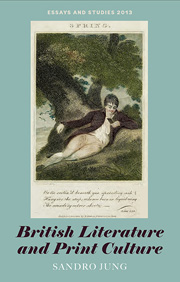Book contents
- Frontmatter
- Contents
- List of Illustrations
- Notes on Contributors
- Introduction
- Tracing a Genealogy of Oroonoko Editions
- The Pilgrim's Progress, Print Culture and the Dissenting Tradition
- Printing for the Author in the Long Eighteenth Century
- Robert Burn's Interleaved Scots Musical Museum: A Case-Study in the Vagaries of Editors and Owners
- Packaging, Design and Colour: From Fine-Printed to Small-Format Editions of Thomson's The Seasons, 1793–1802
- Print Illustrations and the Cultural Materialism of Scott's Waverley Novels
- Beyond Usefulness and Ephemerality: The Discursive Almanac, 1828–60
- The Last Years of a Victorian Monument: The Athenaeum after Maccoll
- Index
The Last Years of a Victorian Monument: The Athenaeum after Maccoll
Published online by Cambridge University Press: 05 October 2013
- Frontmatter
- Contents
- List of Illustrations
- Notes on Contributors
- Introduction
- Tracing a Genealogy of Oroonoko Editions
- The Pilgrim's Progress, Print Culture and the Dissenting Tradition
- Printing for the Author in the Long Eighteenth Century
- Robert Burn's Interleaved Scots Musical Museum: A Case-Study in the Vagaries of Editors and Owners
- Packaging, Design and Colour: From Fine-Printed to Small-Format Editions of Thomson's The Seasons, 1793–1802
- Print Illustrations and the Cultural Materialism of Scott's Waverley Novels
- Beyond Usefulness and Ephemerality: The Discursive Almanac, 1828–60
- The Last Years of a Victorian Monument: The Athenaeum after Maccoll
- Index
Summary
Question: how did a nineteenth-century dinosaur publication like the Athenaeum (1828–1921) prepare for the twentieth century? Answer: it appointed a new editor. This essay aims to look at the print legacy of this new editor, Vernon Horace Rendali (1869–1960), who in spite of the enormity of the task loaded onto his shoulders, has remained an unknown entity in print-culture history. As was often the case it was through the columns of the Athenaeum that the change of captain was announced:
Mr Maccoll, who will on the 1st of next January have been the chief editor of the Athenaeum for over thirty-one years, i.e. since December, 1869, retires with the New Year from this position, and will be succeeded by his assistant editor, who will give up other work to assume the post of principal editor.
This sudden resignation of Norman Maccoll (1843–1904) as editorin-chief of the weekly was to signal a new but unexciting path for this major Victorian periodical. His assistant editor, Vernon Rendall, had already carried out the editorial duties for several years before being entrusted with the sole management of the prestigious publication. The result of his reign as an editor was not really something he could boast about but he did try hard to make sure the Athenaeum continued to be the cultural flagship it had been up to then. In short, Rendall continued the publication policy he and Maccoll had followed in the previous years.
- Type
- Chapter
- Information
- British Literature and Print Culture , pp. 195 - 212Publisher: Boydell & BrewerPrint publication year: 2013

